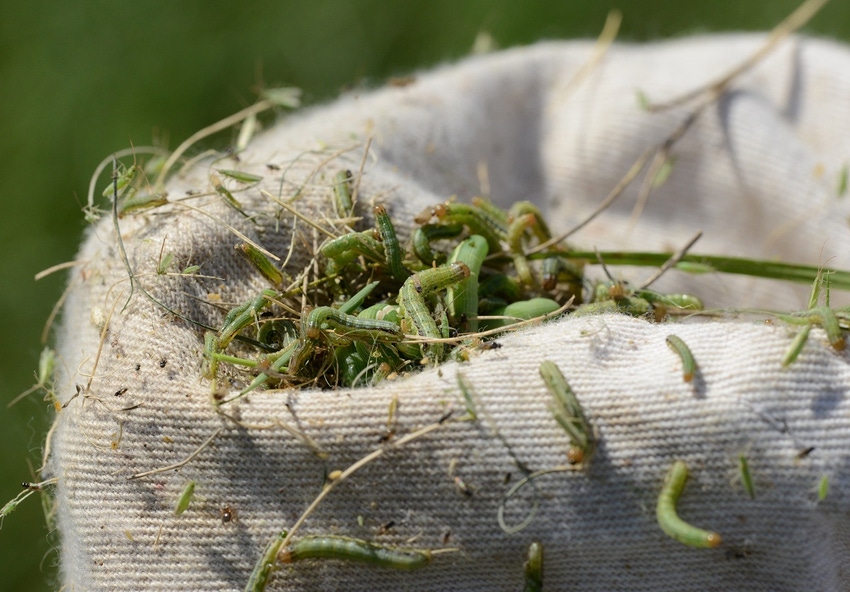
Texas farmers and ranchers are warned this week to look out for and be ready to adjust production plans to avoid injury from two damaging insect pests.
High Plains wheat producers may want to delay planting to avoid damage from grasshoppers, and across the state conditions are right for an explosion of fall armyworms, say Texas AgriLife Extension specialists in Amarillo and Dallas.
High Plains wheat producers typically begin planting wheat in September. They may want to wait a month this year, says Extension agronomist Jourdan Bell and entomologist Ed Bynum, Amarillo.
Extremely heavy pressure from grasshoppers, other insects and diseases due to the wet year, producers should wait until growing plants or “green bridge,” is broken, say Bell and Bynum.
“While we know wheat producers generally begin to plant in September, it really would be best if they could wait until mid-October to avoid grasshoppers and other issues,” Bell said. “The risk will be losing some of the grazing in the fall, but wheat that is planted earlier is more susceptible to insects and pathogens.”
Bynum says grasshopper numbers that built through the summer have not decreased. “Grasshoppers are still here, and they will be here until we have a good hard freeze, so it could be late October,” he said. “Young wheat will be attractive to them, so they could quickly affect plant stands.”
If producers plant early in spite of the infestation, they should scout for damage once the wheat emerges and they need to be prepared to treat with appropriate insecticide if infestations reach threshold.
Several organophosphate, pyrethroid and other classes of insecticides are labeled for grasshopper control in field crops. Producers, as always, should look closely at the insecticide labels to determine which products can be used on wheat.
For the latest on southwest agriculture, please check out Southwest Farm Press Daily and receive the latest news right to your inbox.
“Our members are very concerned about planting wheat with the number of grasshoppers active right now,” said Steelee Fischbacher, director of policy and marketing at the Texas Wheat Producers Association in Amarillo. “Many farmers are considering delaying their typical seeding date, but it will be difficult to make that decision if timely rains occur.
“Farmers who are planning on seeding early for grazing will definitely be looking at options for spraying, which will add an expense to the crop. We have heard reports of grasshoppers completely eliminating fields of volunteer wheat,” she said.
As corn and other summer crops are harvested, grasshoppers will move out of those fields looking for greener, tender plants.
Fall armyworms on the march
Forage producers should watch for fall armyworms.
Fall armyworms like dry weather followed by rain in the late summer and early fall, says Allen Knutson, Texas A&M AgriLife Extension Service entomologist, Dallas.
“Given their immense appetite, great numbers and marching ability, fall armyworms can damage entire fields or pastures in a few days,” Knutson wrote in a recently updated factsheet on the pest, “The Fall Armyworm – Pest of Pasture and Hay – 2015.”
Knutson said armyworm infestations of pastures and small grain may seem to explode over night but the pests may have been too small to detect for as much as two weeks before the “explosion.”
“Actually they’ve been out feeding in fields for two weeks or so, but they’re so small they’re easily overlooked,” he said. “That’s why it’s important to check the fields to detect the armyworms when they�’re still small, maybe only a half- to three-quarters inch long.”
Small fall armyworms are easier to control than nearly mature larvae, which measure 1 inch to 1.5 inches long. And large larvae do more damage.
“The key to managing fall armyworms is frequent inspection of fields to detect fall armyworm infestations before they have caused economic damage. Once larvae are greater than three-quarters inch long, the quantity of foliage they eat increases dramatically,” Knutson said. “During their final two to three days of feeding, armyworms consume 80 percent of the total foliage consumed during their entire development.”
Producers should scout early in the morning and during cool, cloudy weather. Scouting means getting up close and personal—down on hands and knees to examine the grass canopy closely.
“Sometimes it helps to run your hand roughly through the grass and then pull back the grass to see the armyworms that have fallen to the ground. Also, areas of the leaf where the green has been eaten away, leaving only clear leaf tissue, the ‘window pane’ effect, is evidence that armyworms are active in the field. A sweep net also works well to sample fall armyworms.”
About the Author(s)
You May Also Like






